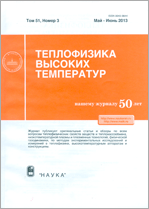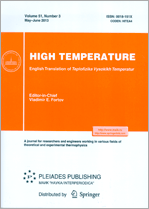|
|
Teplofizika vysokikh temperatur, 2013, Volume 51, Issue 1, Pages 47–55
(Mi tvt54)
|
 |
|
 |
This article is cited in 11 scientific papers (total in 11 papers)
Thermophysical Properties of Materials
Application of the embedded atom model to liquid mercury
D. K. Belashchenko
National University of Science and Technology (Moscow Institute of Steel and Alloys), Leninskii pr. 4, Moscow, 119049, Russia
Abstract:
The pair contribution to the potential of the embedded atom model (EAM) for liquid mercury has been corrected and arranged in a more convenient analytical form. A series of 2000 atom models of liquid mercury has been developed using molecular dynamics at temperatures up to 1673 K, and a good agreement with the data on density has been obtained. The pair correlation functions (PCFs), energy, bulk compression modulus, and self-diffusion coefficients have been calculated. Standard deviations of the PCF of the models from the diffraction PCF of mercury at all temperatures except for 293 K are rather high (0.08–0.10). As in the case of alkaline metals, the energy of the models at high temperatures is lower compared with actual mercury, which is due to insufficient adequacy of the EAM potential and neglect of thermal energy of electrons in the embedded atom model. Using the data on shock compression of mercury, an equation for the embedding potential of the EAM is proposed, which is suitable for description of strong compression states, and an agreement has been obtained with the experimental data on the energy and pressure of mercury along the Hugoniot curve at pressures up to 46 GPa.
Received: 12.12.2011
Citation:
D. K. Belashchenko, “Application of the embedded atom model to liquid mercury”, TVT, 51:1 (2013), 47–55; High Temperature, 51:1 (2013), 40–48
Linking options:
https://www.mathnet.ru/eng/tvt54 https://www.mathnet.ru/eng/tvt/v51/i1/p47
|


|





 Contact us:
Contact us: Terms of Use
Terms of Use
 Registration to the website
Registration to the website Logotypes
Logotypes








 Citation in format
Citation in format 
